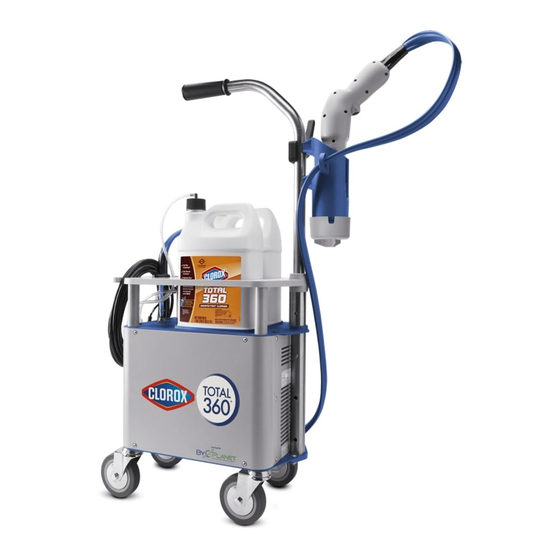CLOROX Total 360 Manual do operador - Página 9
Procurar online ou descarregar pdf Manual do operador para Pulverizador de tinta CLOROX Total 360. CLOROX Total 360 12 páginas. Electrostatic sprayer

MAINTENANCE
In order for the Clorox Total 360™ Electrostatic Sprayer to remain
functional, the equipment should be cleaned on a regular basis. In
addition to general cleaning of the unit there are three user-serviceable
areas: air filter, sprayer nozzle and the peristaltic pump that should be
maintained and serviced regularly.
Sprayer Body
The sprayer body has no serviceable parts inside. Do not open the unit
shell as doing so will void the warranty on the sprayer. Contact Clorox
Total 360™ Electorstatic Sprayer support center, 1-800-492-9729,
if you need to have your sprayer serviced.
Air Filter
The air filter is located on the backside of the unit and should be
replaced every 1,000 hours of use. In order to remove filter, twist it
counterclockwise until it pulls free from the base unit. Insert new filter
by twisting in clockwise until it is hand tight. Do not overtighten.
Peristaltic Pump
Tube Nuts
1. Disconnect the clear tubing inlet and outlet by twisting the
Tube Nuts counterclockwise until both tubes have separated.
2. Rotate the Cover counterclockwise and pull free from the unit.
Tube Leader Assembly
Carriage Assembly
Cover
3. Remove the Carriage Assembly from the Cover.
4. Remove and discard the old Tube Leader Assembly.
5. Grease the new Tube Leader Assembly with the supplied grease.
6. Replace the Tube Leader Assembly with a new one and reinstall
the Carriage and Cover in reverse order being careful not to
damage the Tube Leader Assembly.
Nozzle
The most important thing you can do to ensure trouble-free operation
of your unit is to rinse the nozzle out with clean water after every
use. By cleaning your sprayer's nozzle after each usage, you will
avoid the long-term chemical buildup that eventually causes clogs,
poor spray patterns and shortened life of the nozzle components. In
addition to rinsing with clean water after each use, the nozzle should
periodically be disassembled and cleaned. Regular maintenance should
be performed. Nozzle maintenance schedule will vary, depending on
how often the sprayer is used and adherence to pre- and post-spray
maintenance guidelines.
It is recommended that you thoroughly read through the service
outline below before performing any regular nozzle maintenance.
To Clean/Inspect the Nozzle Assembly
1. Unscrew the cap from the nozzle base. Clean any debris from or
around any of the interior surfaces with warm soapy water.
2. Inspect for any damage to the liquid tip. If spray pattern was noted
to be inconsistent or nontypical of a healthy symmetrical spray,
remove/replace the liquid tip with an appropriate 7/16" socket
wrench.
3. Inspect nozzle electrode for any signs of electrical arching, burn
and/or corrosion. Gently push down on the spring-loaded contact
to verify a smooth spring return. If any issues are noted, remove/
replace immediately. This is done by gently pulling on the spring-
loaded contact with a pair of pliers. Otherwise service the spring-
loaded contact by applying a generous amount of dielectric grease,
available at any local automotive/hardware store.
4. Be sure to also thoroughly clean all interior surfaces of the nozzle
cover, including the main orifice. Never use a wire brush, file or
sandpaper to clean any surface or orifice.
Important: The nozzle cover should be hand-tightened. Never use
pliers or other tools to tighten it, as this may cause damage. Removal
of the nozzle electrode is not necessary for cleaning.
| 9
